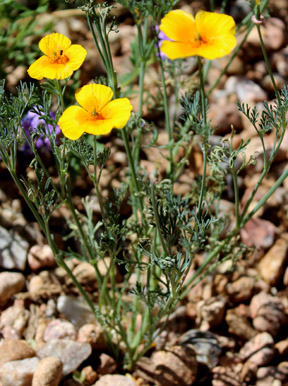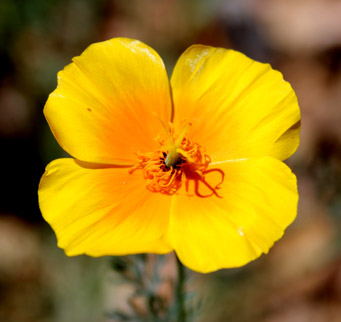The Plant w/Flowers

The Flower

Description
"Eschscholzia californica (California poppy, Californian poppy,[1] golden poppy, California sunlight, cup of gold) is a species of flowering plant in the Papaveraceae family, native to the United States and Mexico. It is an ornamental plant flowering in summer, with showy cup-shaped flowers in brilliant shades of red, orange and yellow (occasionally pink). It is also used medicinally and in cooking. It became the official state flower of California in 1903.
It is a perennial or annual plant growing to 5–60 in (13–152 cm) tall with alternately branching glaucous blue-green foliage. The leaves are alternately divided into round, lobed segments. The flowers are solitary on long stems, silky-textured, with four petals, each petal 2 to 6 cm (0.79 to 2.36 in) long and broad; flower color ranges through yellow, orange and red [2] (with some pinks [3]), with flowering from February to September in the northern hemisphere (spring, summer, fall). The petals close at night (or in cold, windy weather) and open again the following morning, although they may remain closed in cloudy weather.[4] The fruit is a slender, dehiscent capsule 3 to 9 cm (1.2 to 3.5 in) long, which splits in two to release numerous small black or dark brown seeds. It survives mild winters in its native range, dying completely in colder climates." (Wikipedia)
Ethnobotanical Uses
"California poppy leaves were used medicinally by Native Americans and the pollen was used cosmetically, while the seeds continue to be used in cooking.[4][dead link]
The plant is used as an herbal remedy: an aqueous extract of the plant has sedative and anxiolytic actions.[7] The extract acts as a mild sedative when smoked, but the effect is far milder than that of opium because California poppy contains a different class of alkaloids:[8][9]
"An aqueous alcohol extract of Eschscholzia californica has been evaluated for benzodiazepine, neuroleptic, antidepressant, antihistaminic and analgesicproperties. The plant extract did not protect mice against the convulsant effects of pentylenetetrazol, and did not cause muscle relaxant effects, but appeared to possess an affinity for the benzodiazepine receptor. The extract induced peripheral analgesic effects in mice but did not possess antidepressant, neuroleptic or antihistaminic effects."[10](Wikipedia)
Internet Resources